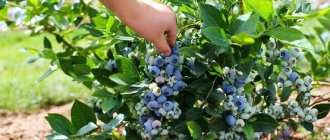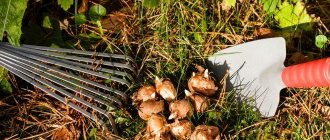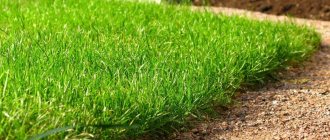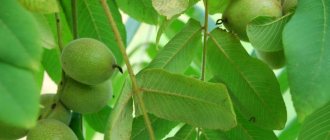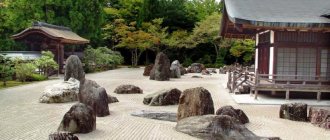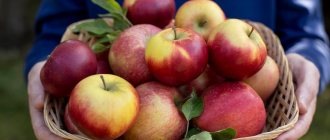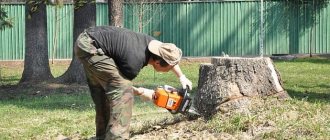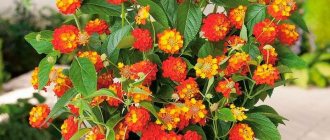If you are tired of being horrified by the prices for nuts, and you have a lot of free space on your plot, you can try growing this crop yourself. The main thing is to choose the right type and variety and find out in advance everything about caring for nuts in the garden.
Hazel, walnuts, hazelnuts, Manchurian, Lancaster, almonds - the selection of seedlings of nut crops in large garden centers can throw a novice walnut grower into panic. Which one is suitable for growing on a personal plot in the middle zone, and which one will just waste your time and effort?
Walnut in the country
In the south of the country, and sometimes in the middle zone, you can find huge walnut trees, which with their crown can shade several standard summer cottages at once. Since no dwarf varieties have been bred, only those with large territories should plant such a nut.
You can grow a walnut either from a nut or from a seedling. The germination rate of nuts is low, so it is better to sow with a reserve. Young trees often freeze out, but trees that have reached 8-10 years old are no longer so defenseless in the face of harsh weather.
In terms of soil, the walnut is unpretentious, although it develops better on sandy and sandy loam, lime-rich soils. In the first years, any crops can be grown in the tree trunk circle, but then the shadow from the crown becomes too thick. The nut does not need special care - young seedlings are protected from frost, and mature trees are simply watered abundantly during periods of drought.
The most frost-resistant walnut varieties are Serotina, Ideal, Astakhovsky - they bloom later.
The nut should be planted in a sunny place protected from the wind. In good weather and the absence of late return frosts, a tree about 10 m high can produce up to 40 kg of nuts per season.
| Tree height | Crown diameter | Lifespan | Entry into fruiting |
| Up to 25 m | Up to 20 m | More than 100 years | For 10-12 years |
Features of culture
The walnut plant (Juglans regia), which is sometimes called Voloshsky, royal, Greek nut, is part of the genus Walnut from the Walnut family. The species is represented by tall (12-25 m) trees with a powerful taproot going to a depth of 3-3.5 m. A tree older than 10 years develops many horizontal appendages, from which lateral shoots begin to grow. The trunk is thick, the gray-ash bark is riddled with deep cracks. The tent-shaped crown is dense and provides dense shade.
Related article:
How to rejuvenate old fruit trees
The leaf is large (30-40 cm), imparipinnate, consists of 7-11 oval lobes (length 8-12 cm) with a sharp tip. If you rub the leaf between your fingers, you will feel a characteristic pleasant smell. The leaves bloom simultaneously with the flowers. The staminate inflorescence looks like an earring, the pistillate inflorescence is located at the ends of the shoots and in the axils of the leaf petioles.
On a note! The plant is monoecious, wind pollinated, so it does not require steam to bear fruit. But if there are other pollinators nearby, the yield increases.
In the first half of autumn, the fruits, which are false drupes, begin to ripen. The shell of the green (immature) fruit is covered with a juicy green fibrous pericarp, which, when the nut ripens, bursts and “throws” it out. The shell of a mature nut is hard and reliably protects the edible, tasty kernel. The weight of the nut in the shell is 6-15 g, size is 4-6 cm.
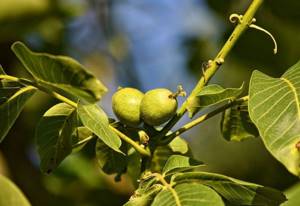
For planting in the middle zone, varieties of garden walnuts adapted to the climate are selected. The following are suitable: Astakhovsky, Giant, Ideal, Robert Livermore, Sadko (Shugin nut), Harvest.
Hazel (hazelnut) in the country
Hazel, or simply put, hazelnut, is found throughout almost our entire country. Unpretentiousness is both the main advantage of this shrub and its main deceit. After all, you can plant hazel either as a root shoot, as a cutting, or as a nut, but it will be very difficult to remove it - it is tenacious and produces numerous shoots. It is no coincidence that this shrub is considered a weed in forestry and quickly invades clearings.
Despite its widespread distribution, hazel is quite demanding on soils. She prefers lime-rich, fertile, loose soils. It calmly tolerates a lack of sun, but in the absence of water it reduces yield. By the way, hazel bears fruit unevenly - there are years when the yield is high, and sometimes there is not a single ovary on an adult bush.
You can grow hazel from a seedling purchased at a nursery, or a young bush brought from the forest. In any case, it is better to plant in the spring, before the buds open. The planting hole must be dug and fenced with slate or boards to a depth of 40-50 cm. Caring for young hazel consists of regular watering and loosening, adding compost (2 buckets per 1 sq.m.) and pruning. For maximum fruiting, the bush should have no more than 10-12 shoots.
| Bush height | Crown diameter | Lifespan | Entry into fruiting |
| 3-5 m | Up to 7 m | 60-80 years | For 5-10 years |
Almonds in the country
Growing almonds in the middle zone is almost an impossible task. Even if the tree takes root, it will not be able to bear fruit in our summer conditions, and you should not expect flowering. It is recommended for residents of the southern regions to grow this crop.
Almonds are light-loving, heat- and drought-resistant, but are unarmed in the face of strong winds and recurrent frosts. The culture prefers soils that are well aerated, high in lime, fertile and light. However, almonds will also grow on loams with an abundance of nutrients, but they will not take root on acidic or saline soil.
Almonds are propagated both by sowing nuts and by grafting onto cherry plum, peach or plum at the age of two. One seedling on a plot is not enough, since several plants are needed for pollination. Starting from the second year, the almond tree needs to be formed, and every fall, organic fertilizers and seasonal fertilizers for the garden based on potassium and phosphorus must be applied.
In the middle zone you can grow steppe almonds and three-lobed almonds. The most adaptable varieties are considered to be the decorative varieties Anyuta, Mechta, Pink Fog, Pink Flamingo.
Caring for almonds is similar to caring for any nut tree, but is complicated by the fact that this crop often freezes. However, steppe almonds are able to recover from the root, so there is no need to despair. For those who try to tame decorative almonds, it is important to remember that for abundant flowering they need annual application of complex mineral fertilizers, for example, Kemira according to the instructions. In addition, the roots must be mulched, the root growth must be mercilessly removed, and the soil under the tree must be regularly checked for acidity and, if necessary, limed.
| Tree height | Crown diameter | Lifespan | Beginning of flowering |
| Up to 5 m | 2-4 m | 60-100 years | For 3-4 years |
Introduction to walnut farming, part 3. Planting a walnut orchard.


 Planting an industrial walnut orchard . The walnut plant has a number of biological and morphological features that fundamentally distinguish it from other fruit crops. A) Firstly, the walnut is characterized by mycorrhizal nutrition. Strains of fungi - symbionts - live and work on the roots of the nut for the common good. Mushrooms, through hyphae, extract water and mineral salts dissolved in it from the soil and transfer the solutions to the roots of the nut. The conductive system of the nut transports solutions to the crown, to the leaf apparatus, where the process of photosynthesis and the synthesis of organic plastic substances occur, which, in turn, ensure the functioning of the walnut tree as a whole. Part of the flow of plastic substances is directed to the roots and provides nutrition to the symbiont fungi. It turns out to be a kind of closed symbiotic circle. It is the presence of mushrooms in the nut food system that determines a number of basic requirements of the walnut tree for the soil. Mycelium, mycorrhiza does not tolerate salinity, waterlogging, high acidity, lack of oxygen, and therefore it is not recommended to allocate drained, silty, saline, wet, flooded areas with a groundwater level of less than 2.5-3 m for walnut plantations. The nut feels comfortable in a rather narrow pH range, not lower than 6.5 and not higher than 7.5. If it is necessary to plant a walnut orchard outside the designated pH range, it is necessary to carry out a set of reclamation, expensive and, as a rule, ineffective measures. In such cases, it is advisable not to “butt heads with Mother Nature”, but to find a more suitable site.
Planting an industrial walnut orchard . The walnut plant has a number of biological and morphological features that fundamentally distinguish it from other fruit crops. A) Firstly, the walnut is characterized by mycorrhizal nutrition. Strains of fungi - symbionts - live and work on the roots of the nut for the common good. Mushrooms, through hyphae, extract water and mineral salts dissolved in it from the soil and transfer the solutions to the roots of the nut. The conductive system of the nut transports solutions to the crown, to the leaf apparatus, where the process of photosynthesis and the synthesis of organic plastic substances occur, which, in turn, ensure the functioning of the walnut tree as a whole. Part of the flow of plastic substances is directed to the roots and provides nutrition to the symbiont fungi. It turns out to be a kind of closed symbiotic circle. It is the presence of mushrooms in the nut food system that determines a number of basic requirements of the walnut tree for the soil. Mycelium, mycorrhiza does not tolerate salinity, waterlogging, high acidity, lack of oxygen, and therefore it is not recommended to allocate drained, silty, saline, wet, flooded areas with a groundwater level of less than 2.5-3 m for walnut plantations. The nut feels comfortable in a rather narrow pH range, not lower than 6.5 and not higher than 7.5. If it is necessary to plant a walnut orchard outside the designated pH range, it is necessary to carry out a set of reclamation, expensive and, as a rule, ineffective measures. In such cases, it is advisable not to “butt heads with Mother Nature”, but to find a more suitable site.
B) Predecessors have a noticeable impact on the development and general condition of the walnut orchard, after planting and during further operation. Fields where long-term herbicides such as Pivot, atrazine herbicides and some others have been used for a long period of time are unsuitable for direct development as a walnut orchard and must undergo a more or less long period of natural disinfection. When making a decision to plant a garden in such areas, it is mandatory to conduct research for the presence of residual amounts of herbicides.
Areas previously occupied by perennial crops, after uprooting, must undergo a 5-year cycle of natural disinfection, during which the risk of bacterial and other infections is reduced, the root remains of the predecessor are partially decomposed and mineralized, and toxins formed during rotting of the root remains are washed out or naturally inactivated .
C) The walnut plant prefers thick sandy loam, carbonate, well-gummed, water- and air-permeable chernozems with a quality rating of 80-100 points, pH 6.5-7.5, with a groundwater depth of at least 2.5 m. The use of other soils that differ from this optimum is possible after proper reclamation adjustments. Soils whose pedological characteristics significantly do not meet the requirements of a walnut tree should not be used for planting walnut orchards, but other uses should be found for them.
D) Walnut has specific requirements for the topography of the site. It is not recommended to place gardens in lower parts of the terrain, in closed beams, or on the shores of reservoirs, since in such places the risk of damage to the nut by later spring and early autumn frosts increases. Peanut orchards should not be placed on hill ridges or high elevations where strong winter winds prevail and the likelihood of winter frost damage increases.
D) The nut tree synthesizes the most energy-intensive products - vegetable oils and protein. This process requires plenty of food and water. It is believed that to fully unlock its biological potential, a walnut tree requires at least 750-900mm. precipitation per year. In the conditions of Moldova, such years occur once every 15-20 years, and the average annual precipitation varies in zones from 450 to 570 mm. per year, this amount of moisture, with the most effective and rational use of it, is enough to produce a harvest of 1.5-2.0 tons of dry fruits per hectare and no more. It is obvious that the limiting factor in the growth of yield and economic efficiency of walnut plantations is precisely the moisture deficit. Since the level of soil fertility of 80-point chernozem allows one to obtain at least 3.5-4.0 tons of dry fruits per hectare. Solving the water supply problem is extremely difficult, mainly due to the lack of high-quality irrigation water. More than 90% of water sources in Moldova have a mineralization level of over 1.5 g/liter. A simple calculation shows that when using an irrigation norm of 6000 m3/ha. capable of compensating for the difference in irrigation moisture, up to 9 tons of harmful salts are introduced at a time. Two or three years of such watering can cause secondary salinization and degradation of the best soil and, ultimately, oppression and death of the walnut orchard!!!
Drip irrigation, widely introduced today, is an unconditional, non-alternative method for vegetable crops, vineyards and intensive walnut orchards with planting patterns of 6x3, 6x4m. unsuitable for traditional walnut orchards with planting patterns of 10x10 meters or more. In the biology and physiology of any plant there is the concept of “directed development, in the Latin version of tropism.” Over millions of years of the evolutionary process, the plant, in the fiercest competition for survival and preservation of the species, has developed a mechanism for directed growth and development of the plant towards a source, for example, light - phototropism. To a nutritional resource - chemotropism. Towards a heat source, when it is in short supply, there is positive thermotropism, and if there is overheating, the plant develops away from overheating, negative thermotropism. In arid conditions, with an acute lack of moisture, the plant very quickly directs its roots towards comfortable moisture, i.e. towards the dropper, so-called positive hydrotropism. The total volume of the root system is reduced, some of the roots are reduced and lose their functions. After a year or two, the plant, so to speak, sits on a “drip needle” and, to a large extent, loses the ability to survive independently in drought conditions. Any failure with watering plunges the plant into deep stress, which causes serious harm to the plant and the harvest. In the presence of high-quality irrigation water and the peculiarities of the powerful walnut root system, which controls the soil horizon and underlying rock for 3-4 or more meters, in walnut orchards it is advisable to carry out powerful water-recharging irrigation with a volume of 1500-2000 m3/ha, in the late autumn months, after leaf fall, when losses water evaporation is minimal. Water soaks the soil profile to a depth of 1.5-2.5 meters, and in dry months it is effectively used by the plant.
Unfortunately, today the consumer is deprived of access to reliable information about the true state of affairs with the quality of irrigation water and about some of the features of drip irrigation in relation to the traditional walnut crop. Numerous companies present drip irrigation as a panacea for all problems and literally “zombie” the potential buyer, deliberately keeping silent and often hiding the true state of affairs. I stepped on this “rake” in 2000. Having decided to plant a small, intensive apple orchard in Redio de Sus, I, realizing that without irrigation, this was impossible, in 1999 I submitted water from two existing ponds for analysis to the AIC Moldova branch. The results of the analysis were the most positive; my lakes consisted practically of mountain water. The system was built and started working. The first years, I could not get enough of it, however, after 4 years the leaves of the apple tree began to turn yellow, and the soil in the area of the droppers began to resemble soap. I took soil samples, again water from the ponds, and submitted them for analysis to an independent expert. The result was stunning, the water was absolutely unsuitable for irrigation, the mineralization level was 2.7 g/liter, and the soil had all the signs of secondary salinization, it became necessary to carry out expensive and lengthy rehabilitation. With new analyzes and conclusions, I went to the AIK, and received the standard answer, “then the water was excellent, but we do not answer the fact that it unexpectedly changed.” The garden had to be uprooted, but no one was found guilty.
E) Pre-planting soil preparation. Issues of pre-planting tillage were touched upon in previous sections, such as uprooting the previous crop, plot planning, adjusting soil fertility, deep plowing, leveling. Regarding deep plowing, in recent years, due to an in-depth study of soil biota, soil genesis, and the massive abandonment of plow, moldboard, and tillage, recommendations have emerged to limit the plowing depth to 35-40 cm. It is considered the most rational to loosen the soil, without turning the layer to a depth of 50-70 cm, which improves the porosity of the soil, its water permeability, and removes the negative consequences of traditional plantation plowing.
9) Transferring the project to reality . Breakdown into blocks, cells, rows and seats. This work requires the performer to have a certain level of geodetic skills.
10) Selection of varieties. a) Specifics of a wind-pollinated plant. Selection and placement of pollinators, a new technique. b) Planting patterns and planting density of varieties with apical fruiting. This is the most uncertain question at present. In the early 70s of the last century, there was a move away from physiologically based nut planting schemes. (Kolesnikov, Shevchenko, Rovsky 40-56 years old) - 16x15, 18x18m and more. The evolution of the walnut goes back tens of millions of years. Paleobotanists find walnut pollen grains in Quaternary sediments. Walnut survived the mass extinction of flora and fauna in the Younger Dryas. This unique plant, this species, has shown the highest ability to survive, adapt to sharp climatic fluctuations and has survived to this day as a plant with a set of clearly formed requirements for environmental conditions. In a word, the nut knows well what it needs and any attempts to impose on it anything that contradicts its biological and physiological characteristics end in failure. It is impossible to argue for the trend toward denser planting patterns that occurred at the turn of the 60-70s of the last century. It is significant that all the authors emphasize that walnut is a purely light-loving plant that does not tolerate any shading or thickening, and then, contrary to all logic, they recommend planting schemes of 8x8, 8x10m. for nut, traditional, upland type of fruiting, grafted onto Juglans regia.
The walnut is characterized by a pronounced phenomenon of allelopathy (mutual oppression), competition within the species. Allelopathy is one of the tools of natural selection, the struggle of a species for a place in the sun. In most cases, plants of the same species, within a community, are tolerant of each other; in the walnut, the opposite is true: the walnut mercilessly and uncompromisingly fights with its fellows, within the species, often to the point of complete self-destruction. Allopathic struggle takes place both in the above-ground part, between the crowns, when they close, and between the root systems, when they come together and penetrate each other. The manifestation of allopathic tendencies significantly reduces the plant’s immunity and ability to withstand negative environmental factors. Frost resistance, drought resistance, yield and quality of fruits are reduced. Conclusion, by creating dense plantings of walnuts, we deliberately create problems that ultimately lead to oppression and death of the walnut orchard. It was noticed that with a planting pattern of 8x8m. oppression is observed already from 8-10 years, with a 10x10 m scheme, by 18-20 years, 12x10, by 25 years. The most rational scheme is 14x10m. – 70 trees per 1 hectare. With this planting scheme, walnut trees have a chance to live up to 40-45 years without any problems. Sparse planting raises the question of the payback period for a walnut orchard, and this problem is successfully solved by a system of compaction and inter-row crops. Our farm has developed and tested a method for accelerating the payback of a walnut orchard. The main thing in using compaction and inter-row crops is not to forget that the nut is the BASIC!!!, a promising crop and not to harm it, as often happens.
d) Planting schemes for varieties with lateral fruiting. smoothing out the phenomenon of allelopathy. If soil and climatic conditions allow planting an intensive garden with varieties that have lateral fruiting, then planting schemes of 8x6, 8x4, 6x4 m are used. From 200 to 400 or more trees per hectare. Such a garden is capable of producing a harvest of 1.5 - 2 tons already in 4-5 years.
The potential of an intensive garden is 4-5 tons or more, provided it is FULL!!! Providing trees with water and mineral nutrients. In this case, the phenomenon of allelopathy does not appear.
eleven). Garden care consists of maintaining the soil in a clean and loose condition , timely whitewashing of the trunks, which protects the bark from sunburn and frost damage, and protection from diseases and pests. All this is described in detail, year by year, in the Project.
To be continued . Postal code - 5911 Tel.fax, GSM +37367253017 E-mail Web: www.gospodarulrediu.com Web: www.renastereanucului.com
Red and green hazelnuts in the country
Hazelnut is a cultivated variety of hazel. It is a little more capricious in cultivation, but the yields are larger, more stable, and the bushes themselves are much more decorative. Hazelnuts are planted in 4-5 copies, and one of them must have green leaves - this is the only way to ensure full pollination.
The best varieties of hazelnuts with red leaves are Academician Yablokov, Isaevsky, Ekaterina, Pushkinsky red, Ivanteevsky red, Kudraif, Moscow early, Moscow ruby, Purple, with green leaves - Tambov early, Tambov late, Severny, Pervenets.
Hazelnuts are moisture-loving and grow well in the shade, on chernozem and gray forest soils. Does not take root in salt marshes and swampy and saline soils. Hazelnuts love abundant watering and grow quietly in areas with high groundwater levels. It is advisable not to plant it in sunny areas, so as not to provoke too early flowering.
Starting from the third year, the bushes begin to form, trying to achieve 8-12 stems evenly spaced from each other. The branches are not shortened, but thinned out, since fruiting occurs on annual growths. To obtain annual harvests for hazelnuts, you need to add organic matter every fall (compost or rotted manure at the rate of 2 buckets per 1 sq.m.), and every 2-3 years in the spring, 60-80 g of potassium sulfate and 100 g of superphosphate per sq.m. m.
| Bush height | Crown diameter | Lifespan | Entry into fruiting |
| 3-8 m | 5-7 m | 30-50 years | For 6-8 years |
When and how to plant seedlings
You can plant walnuts in the garden in autumn or spring. Autumn planting is preferable if it is not possible to water regularly in the spring. Gardeners have noticed that a seedling planted in the spring and caught in a drought suffers from frost more than one planted in the fall. In the spring, you need to have time to plant while there is a lot of moisture in the soil and before the heat sets in.
When planting in the fall, be sure to take into account the period before the onset of cold weather - if you plant it late, the tree will not have time to adapt. In areas with cold winters, it is better to plant in the spring. In warm climates, seedlings are planted in early spring and late autumn.
One-year-old seedlings take root best; two-year-old seedlings are shortened to ½ m when planted.
How to plant:
- soak seedlings with an open root system in water for 0.5-1 hour, and water them in a coma of earth to saturate them with moisture;
- damaged and twisted roots need to be trimmed, too long ones should be shortened a little;
- At the bottom of the hole, lay drainage made of fine crushed stone, pebbles, and pour a mound of prepared soil on top;
- Place a lump of earth on the mound; if the roots are open, then spread them along the edges of the mound (you can dip them in a clay mound), and place a peg nearby for support;
- fill 2/3 of the volume of the hole with soil, water when the water is absorbed, in small portions, without tamping, add the rest of the soil (leave the root collar at soil level), water again;
- tie the trunk to the support;
- build a circle around the trunk so that the water does not spread when watering;
- mulch with straw and dry grass.
Related article:
7 trees that should be in every garden
Manchurian nut in the country
The huge Manchurian walnut tree is grown only for the sake of exoticism or for decorative purposes by owners of truly gigantic plots. Its half-meter leaves are capable of “protecting” a piece of land not only from light, but also from rain, so it is quite difficult to grow something under a nut.
The fruits themselves, which ripen in abundance and are not afraid of frost, have a very hard skin. So hard that the nut can only be cracked with a vice or after heat treatment. The pulp of the Manchurian nut, although tasty, is quite small in size and therefore has no value.
| Tree height | Crown diameter | Lifespan | Entry into fruiting |
| 25-28 m | Up to 10 m | Up to 250 years | For 12-15 years |
Where to plant a walnut tree
If you are not a resident of a warm and gentle climate, where whatever fell from a tree sprouted on its own, then pay attention to the following points.
- Walnut loves the sun, but light partial shade will not hurt it.
- No heavy, swampy, acidic soils. Otherwise, either the root rots or will not bear fruit.
- Even if the tree has taken root, be prepared to wait for it to bear fruit for 5 to 10 years, while the crown will grow. That is, you need care and a place where the nut will not interfere.
- The seedling needs regular watering, so plant it where there is access to water.
- If space allows, plant several trees - this way, some will probably take root.
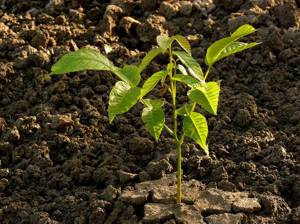
When you have chosen a place, you can begin preparing the hole.
Important! When purchasing a nut, check what variety is being sold. Read about it online, whether it is suitable for your region and what fruit it produces.
Lancaster nut in the country
A completely new crop, about which little is known so far, has become a hybrid of gray and heart-shaped nuts. The main advantages of the tree are that the lower branches can be removed during shaping, and it will not shade the surrounding area; the nuts fall off on their own after ripening, and they are large and with very tasty pulp, and also do not have partitions inside.
You need to sow several nuts at once, and do this in the fall (September - early October), protected from mice, and in clean soil (nuts will not germinate in the grass). They are planted shallowly (to a depth of 5-7 cm or simply sprinkled with fallen leaves) and immediately in a permanent place, because the Lancaster nut tolerates replanting very poorly. It does not freeze in the middle zone, so you don’t have to worry about shelters, it adapts to most soils (except for highly acidified, swampy and salt marshes), prefers organic fertilizers (2-3 buckets of mature compost per 1 sq.m. of tree trunk circle). Fertilizers can be applied both in spring and autumn, making sure to thoroughly water the tree afterwards. By the way, you will need to monitor the watering of the nut only in the first 5-6 years, then it will be able to take care of itself.
| Tree height | Crown diameter | Lifespan | Entry into fruiting |
| Up to 10 m | 5-6 m | Unknown yet | For 6th year |
In catalogs you can also find ailantholifolia, gray, black and heart-shaped nuts, but they are so rare on sale that only experienced breeders can grow them. In addition, some of these species, with a huge crown, have very tiny kernels and are of no value to the gardener.
Overview of varieties
The most winter-hardy varieties today are the following: “Ivanteevsky purple” is my favorite. The variety is very productive, and, as my experience has shown, it is self-fertile and beautiful. It is important that it almost does not form shoots! “Akademik Yablokov” is a late red-leaved variety with beautiful bowl-shaped bushes. The nuts are large, elongated, similar to acorns, collected in clusters of 10 pieces, tasty, with a thin shell. Productivity up to 10 kg per plant. A very good pollinator for it is “Tambov early”. “Tambov Early” - distinguished by very early ripening. Already in mid-August you can collect nuts. The bush is powerful and wide. Has large green leaves. A good pollinator for most varieties. “Moscow Rubin” is another favorite of mine! It is distinguished by beautiful red foliage, has very large inflorescences up to 15 pcs. Late ripening variety with high yield. An excellent pollinator for other varieties. The nuts have a thin shell. “Firstborn” is a wonderful variety! It is distinguished by small increments, forming a fairly compact bush. The nuts are very sweet, elongated in shape. The leaves are green. It blooms very beautifully - with a large number of earrings. Fruits regularly. “Sugar” is another very interesting variety. The name speaks for itself. The quality of the fruit is very high. It compares favorably with other varieties due to its high oil and sugar content. The leaves and even the nuts are dark cherry in color. Unfortunately, I don't have it yet. We definitely need to plant it! “Isaevsky” is a variety that deserves increased attention. It is distinguished by very large nuts of high taste. The fruits can be stored for 3–4 years. Green-leaved productive variety. Winter hardiness down to -40ºС. Can be recommended for northern regions. All of the above varieties are resistant to return frosts, grow well both in the Moscow region and further north, are distinguished by early fruiting and produce good yields. Experts recommend planting 2–3 varieties in one area for mutual pollination. With a modern set of varieties, this can be quite an interesting activity, especially for lovers of large harvests. Harvesting begins at the first signs of ripening. At this time, the nut skin begins to turn brown, yellow or brown (depending on the variety). It is undesirable to allow nuts to fall off. If this happens, collect them as quickly as possible. After all, everyone is in a hurry to eat sweet nuts, including mice. The collection is carried out manually; you can tear off all the fruit at once. The collected nuts are laid out on a towel and dried in a shady place, preferably indoors. During drying, the nuts are easily separated from the peel and become brownish-brown in color. After collecting the peeled nuts, they must be dried for two weeks at room temperature. Then the resulting harvest is poured into canvas bags. These nuts are consumed both fresh and roasted. They can be used in cooking, bake cakes with nut filling, make sweets in the form of candied nuts or honey. Well, just a wonderful product from our garden plots! Be sure to plant hazelnuts if you haven't already. Then cute fluffy squirrels and stately beautiful woodpeckers will definitely come to your site. We always look forward to meeting these cute forest dwellers.

